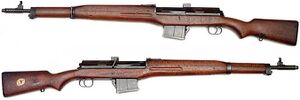Tóth OP-30
Jump to navigation
Jump to search
This article is incomplete because it is pending further input from participants, or it is a work-in-progress by one author. Please comment on this article's talk page to share your input, comments and questions. Note: To contribute to this article, you may need to seek help from the author(s) of this page. |
| Tóth Önrakodó Puska 30 OP-30 | |
|---|---|
 | |
| Type | Semi-automatic rifle |
| Place of origin | |
| Service history | |
| In service | 1930—1955 (Ruvelka) |
| Used by | |
| Wars | Siduri War Granika Border War Seven Day War |
| Production history | |
| Designer | Veronika Tóth |
| Designed | 1928 |
| Produced | 1929—1949 |
| Specifications | |
| Weight | 4.71 kg |
| Length | 1,214 mm |
| Barrel length | 622 mm |
| Cartridge | 6.5×55mm |
| Action | Direct impingement gas operated |
| Rate of fire | 40 RPM (rounds per minute) |
| Muzzle velocity | 840 m/s |
| Effective firing range | 800 m |
| Feed system | 10-round detachable box magazine |
| Sights | Hooded front blade, adjustable rear iron sight |
The Tóth OP-30 (Ruvelkan: Önrakodó Puska 30; “Self-Loading Rifle 30”) is a Ruvelkan self-loading rifle that served as the main infantry rifle of the Imperial Armed Forces of Ruvelka during the Siduri War and its aftermath before eventually being replaced by the Acrean StG 51 in 1955.
The OP-30 later became an icon of the Zemplen independence movements after large numbers of the rifle were covertly provided to groups fighting against Syara as part of the Granika Border War.